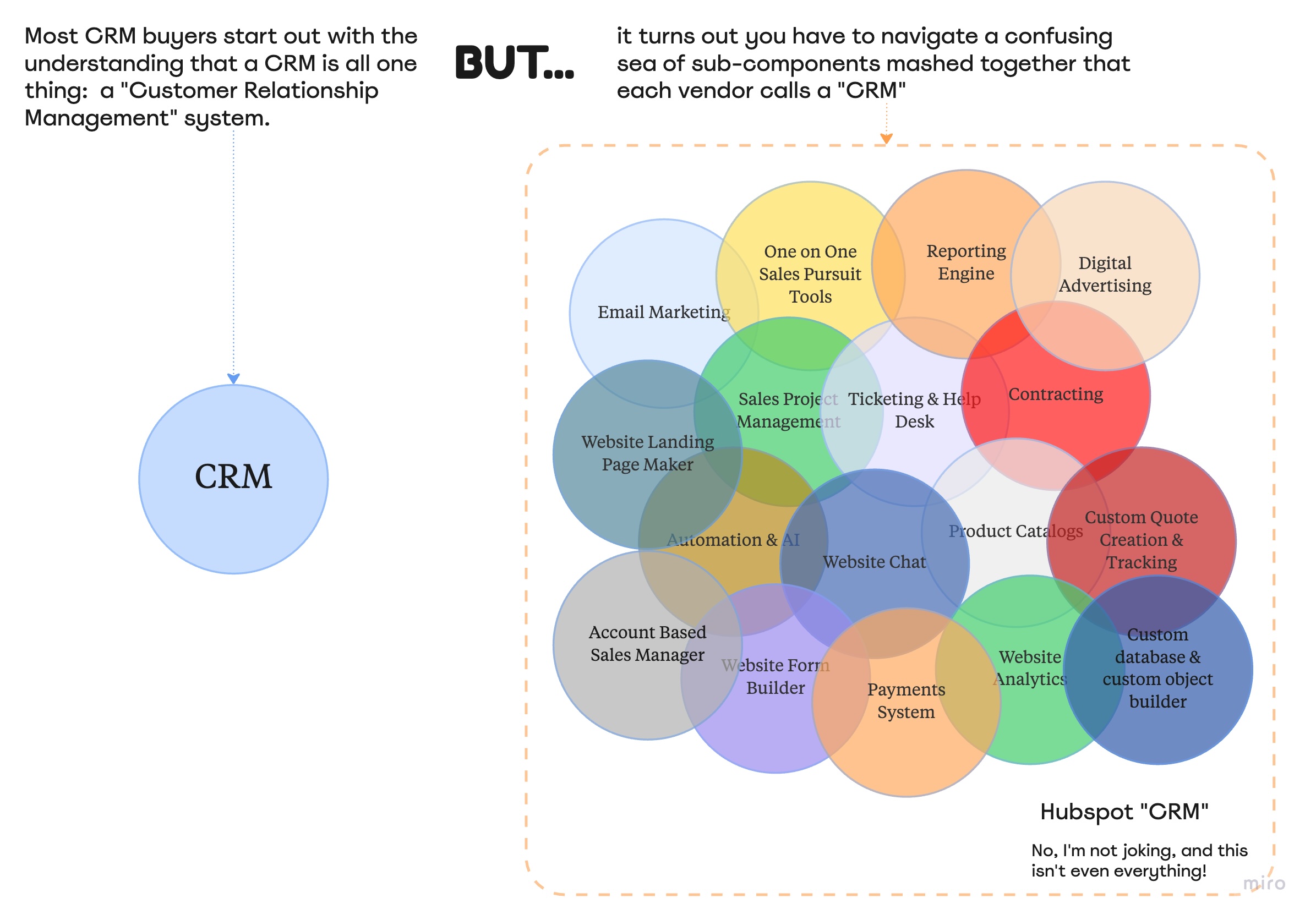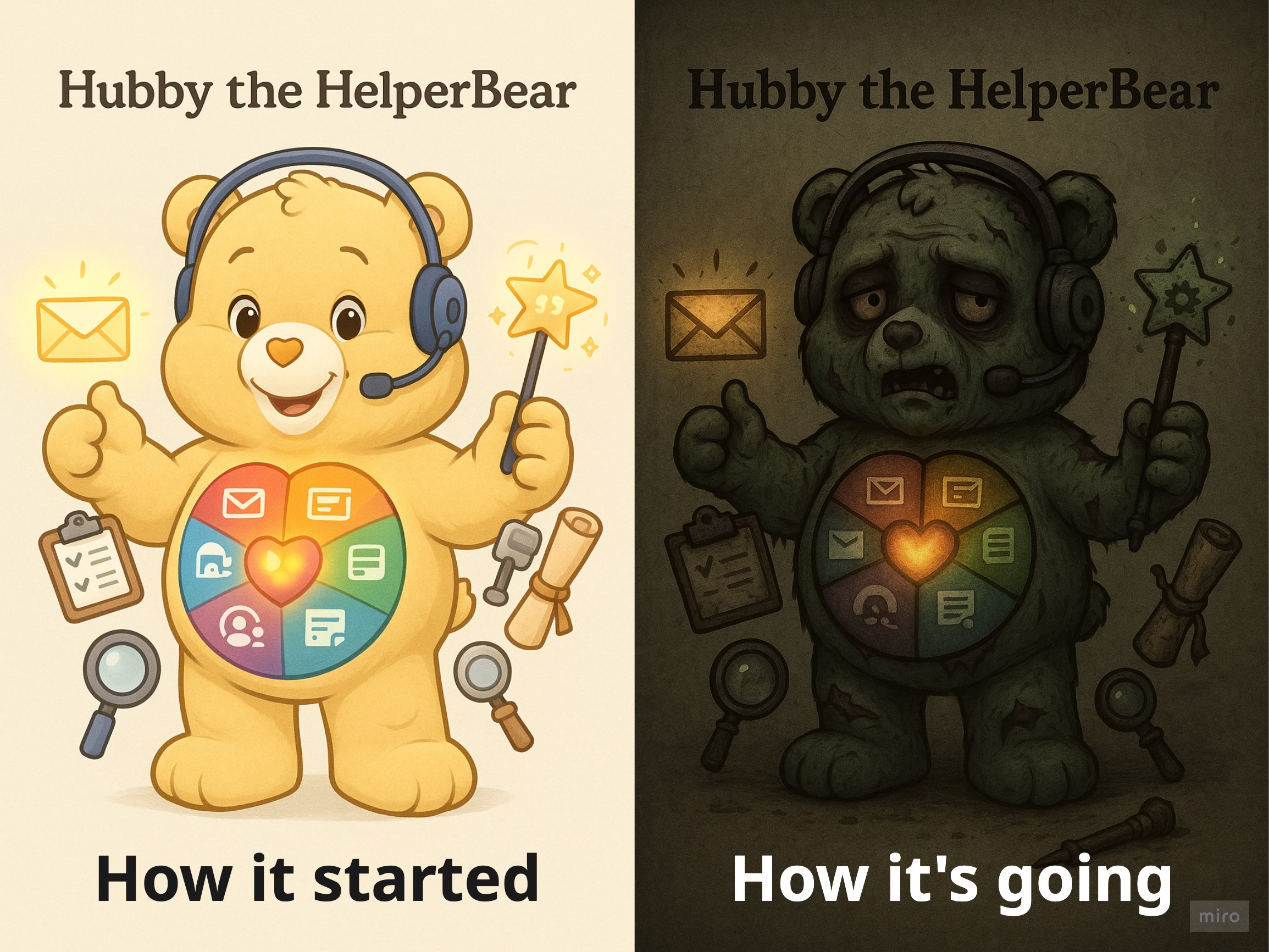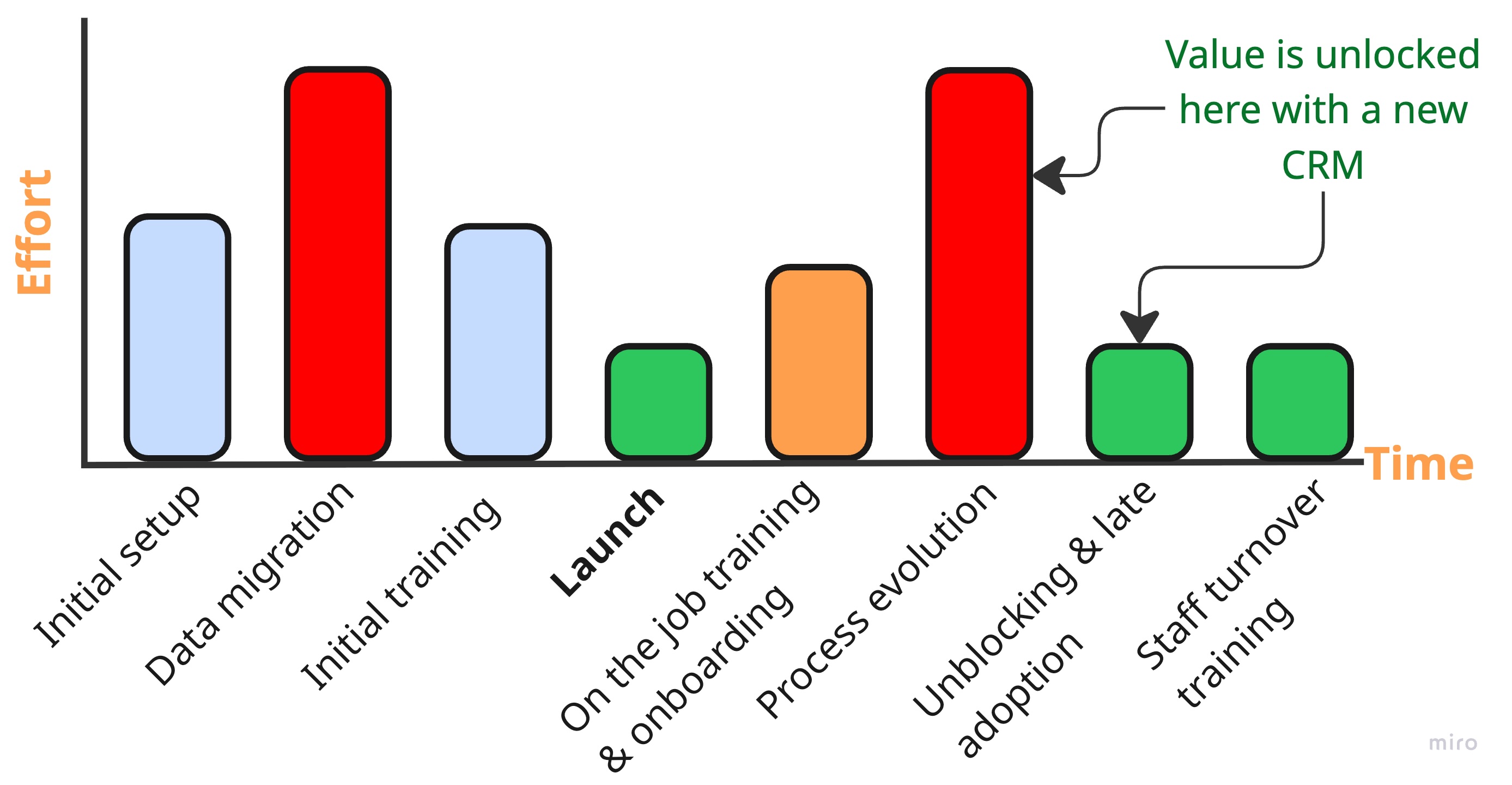
Consultant’s Secrets: The insiders guide to selecting your next CRM

What the experts aren’t telling can cost your organization plenty. Part one of a series on the mysteries of CRM
Introduction
The digital technorati in their infinite wisdom have continued to use the term CRM - Customer Relationship Management System for software now for about 40 years. However during that time we went from visiting people’s houses or businesses door to door to visiting people’s social media feeds. Countless CRM companies have come and gone, each a product of their era, their biases, and the problems they wanted to solve. The term has never changed. Buying a CRM is more complex and confusing than ever, and we’re now seeing the latest new MarTech attempt to tilt the CRM windmill faltering, and being folded into the CRM buying landscape. (The Digital Experience Platform, or DXP, turns out to be just another CRM with a lil’ modern sugar)
Today this mishmash of evolutionary functionality and bucket based naming of everything as a CRM means that most organizations don’t really know what they’re shopping for or buying, when they look for a CRM. Don’t feel bad though, because this situation is like if you went shopping for a car and every dealership offered you a metal bin filled with parts, tires, exhaust components, a few chairs, and said “here’s your car!”

How do you navigate this mess?
Let’s start out by stating an obvious, but overlooked fact, CRMs are not all created equal. Every CRM you can buy was designed and built focused on one stage of the conversion/sales funnel and then for most of them they expanded outwards as they got more success to try and address other parts of the funnel. For example, MailChimp, as the name implies, started out 100% focused on email marketing, (the top of the marketing funnel for many businesses) and now have built out a variety of other pieces to sell Mailchimp as an all in one CRM to small/medium sized businesses.
As a buyer, you should clearly prioritize the parts of your conversion funnel that are your biggest pain points, and the parts where your internal users are the most sophisticated or have the most capacity. Knowing this will help you identify CRMs that started out focusing on your core pain area.
Knowing how CRMs evolve, you’ll also start to understand that the more parts of the sales/conversion process that you need a CRM to handle for you, the more you will likely run into uneven and spotty areas of quality or depth of functionality in a particular CRM. This is often the reason that organizations end up with different CRMs being used in different departments, because CRM A is great at the comms department's needs, and crappy for the major giving or white glove sales team's needs.
More money in CRM land typically does not deliver more quality. CRMs are a lot like luxury goods. Some are made with better materials and care, and others just cost more because of the label on the side. The most charitable metaphor for the CRM industry is that they price things like construction equipment, where the more expensive stuff typically can handle more load/volume and typically have strategies to handle complex ecosystems of supporting software that needs to be integrated with.
CRMs pricing is also evolving rapidly towards “usage” based pricing and away from simple seat based pricing. This means that unlike typical capital expenses where you buy it and then depreciate it down until it is time to buy another, you need to have cost review planning built into your procurement. (Ask me more about this if you are curious)
Which CRM is a good fit for YOU?
Ask the big questions first. It’s tempting to dive into tactical questions and focus on features, you can recognize tactical questions because they are things like "does the CRM handle use case X really well, or does it have an integration to system Y.” These are the wrong questions to start out with, what you really want to know when you start shopping is who are you as a buyer, not what are all the possible solutions out there.
Strategic questions you should ask include:
- Which departments or job functions within my organization are going to be the primary day to day users of this CRM?
- How mature and sophisticated are these users compared to peers, compared to the industry leaders, and compared to power users in other industries?
- How well documented are our own standard operating procedures?
- What interdepartmental pipelines leverage my current CRM, or are we financially committed to supporting the new CRM?
Some examples of these pipelines:
- Marketing buys ads and creates marketing qualified leads that are then handed over to sales for opportunity pursuit and win/loss
- Minor giving has tools in place to identify potential major gift givers and deliver them to major gifts officers for pursuit?
- Volunteer team coordinates with the marketing team to make sure customers build brand loyalty and affinity by being made aware of volunteer opportunities?
Then calibrate your change management tolerance. Some organizations are willing to dive into “digital transformation” and others just want a nicer rain jacket. Knowing who you are will help you understand if you should buy something that looks like how you work today, or if it looks like where you want your organization to be tomorrow.
Evaluating fit, not just features
That first focus area CRM was built to address will be its most mature, the most thoughtful and innovative, and the one that has had the most iterative improvement from user feedback and real world scenarios having to be accommodated. Doing some light research here will help you identify good candidates before you even see a demo. For example, if you are struggling to find leads, a bottom of the funnel “closing deals” focused CRM such as Pipedrive likely won’t be as helpful as something more “top of the funnel” oriented such as ActiveCampaign or Nimble.
Secondary areas the CRM covers can become as mature, but this takes time. The newer an area of the sales funnel covered by the CRM the less robust and feature dense that area is. These secondary areas typically copy feature sets from well known peers rather than offer innovative approaches. If the CRMs primary focus area is your primary pain area, and their secondary areas of product maturity match your organizational sophistication & staff capacity, then you know you are unlikely to be unhappy.
Are you shopping for heavy iron? Enterprise CRMs often need you to deploy a dedicated team of 10-20 staff to utilize their functionality effectively. On the other end of the spectrum are CRMs designed for solo operators or teams of 2 or 3. The trade off that most people don’t know they are buying isn’t in the functionality of the CRM, it’s in the cost of configuring, training, onboarding, and maintaining the quality of outreach using the CRM. Buying a CRM that is designed for your team size is essential if you want to get good returns on your purchase.
The number one friction point I see with most businesses is OVER buying CRM and then suffering through chronic UNDER staffing.
Gotchas

FrankensteiRM
When a CRM product starts to take off, typically the owners of that CRM will decide they need to expand their tool's functionality to cover more of the sales funnel. The fastest way for them to do that is to acquire a company that already does that and try to bolt it onto their CRM. Sadly, these bolt-ons don’t fit together nicely, the UI is typically quite awkward, and there are all sorts of edge case bugs that you, the end user, get to figure out how to solve.
The poster child for this strategy is Salesforce, which has bought: (and these are just the highlights!)
- Slack to replace their crappy internal chat tool, after they bought Quip to help them fix their crappy chat tool, chatter.
- Tableau to supplement their basic reporting capabilities
- Demandware to plug in their B2C functionality gaps (SF Commerce Cloud)
- ExactTarget (SF Marketing Cloud) to replace their crappy email personalization platform, confusingly overlapping with their mass emailing & kinda personalizing platform Pardot. (SF Marketing Cloud Engagement)
- Own Company (yes that’s the name of the company they bought) to plug in gaps in their data backup capabilities for enterprise (Own from Salesforce)
- Click Software to fill in gaps in their scheduling capabilities (rolled in, and EOL’d as a brand)
- Vlocity to help them provide industry specific flavors / configurations of salesforce (SF Industries)
- Krux to let them compete in the Data management space with salesforce (SF DMP, now EOL’d as well)
- And in 2025 they just blew $8 billion on Informatica to try and solve their AI woes.
Anyhow you get the point, why have so many people been frustrated by “Salesforce Cloud” over the years? Because so much of it is tied together with bailing wire and hope, with key parts of the platform developed by different teams, at different companies, using different technologies, with different priorities. Salesforce, and other vendors, obscure these shenanigans by rebranding everything as SF Cloud Thingy X. You need to watch out for this kind of thing as a buyer, and keep your expectations of what “everything under one roof” solutions will provide in terms of efficiency and scaling.
Buying the plane and forgetting the pilot
Planes don’t fly themselves and neither does your CRM. I see this overlooked during CRM selections all the time, where CRM configuration & unblocking support, and total cost of ownership estimation are not a primary factor in selection criteria. If you are looking for a zero-staff CRM, they don’t exist, and if you plan for zero staff to manage your CRM what you are really doing is signing up all your existing staff to become untrained amateur CRM admins in addition whatever you think you are paying them to do. You will regret this. =)
Every CRM has a staffing range required to manage & configure it, separately from whatever staff it’s designed to deliver CRM functionality to. If you plan around the staff you can afford to deploy to support the CRM, you’ll get a lot more ROI on the money & time spent on the CRM than if you don’t. This is because CRMs deliver value AFTER launch when departments evolve their existing processes to new ways of working that deliver productivity & efficiency gains. Guess what, they get better over time as your staff get more experience, sophistication, and understanding of the CRMs functionality. Executives need to understand this value proposition.
I’m not saying you have to rush out and get a full time employee, but you should build a staffing plan into your criteria, and the more complex and “enterprise” the CRM you are considering the larger and heavier the rock will be that you’ll be metaphorically stubbing your toe on very soon. For most organizations just planning for quarterly expert freelancer support would increase their CRMs value to the org tremendously.
Much of the CRM effort to produce value happens AFTER a new CRM is launched:

The value a new CRM can deliver will trickle out over time if it isn’t nurtured intentionally. You need to intersect the people in your organization with deep knowledge of your business process, your friction points, and the things you do today that are inefficient that could be MADE efficient with your new CRM with a CRM expert who can turn those insights into tailored configuration & automation in the CRM. In this labyrinthine cosmos of CRM commerce the technology often appears as an alien, overwhelming firmament. Yet, the true value in this digital wilderness is delivered by the bard who can weave the intricate threads of technology into the very warp and woof of a business's quotidian existence. So go forth shopping not for a CRM with the mindset of someone shopping for an outfit they’ll wear every day, tailoring, repairing, and improving as they get more comfortable in it.
Looking forward
In future articles we’ll dive a little deeper into these questions and look at how to select a CRM for a midsized org (8+ dedicated comms & sales staff) and how to select a CRM for a solo/small business. We’ll also take a look at the CRM migration itself, what are the stages of that, how does that work for big organizations, and how can you plan for that strategically. Finally we’ll talk about process evolution, and how to support and incentivize that in your next CRM migration. If you have other questions or areas you’d like me to explore let me know!

Chat with the author
If you'd like to make a connection and perhaps collaborate on something:I'd love to talk with you!No matter if you want to build your professional network,or think there might be a great opportunity to to work together or partner.